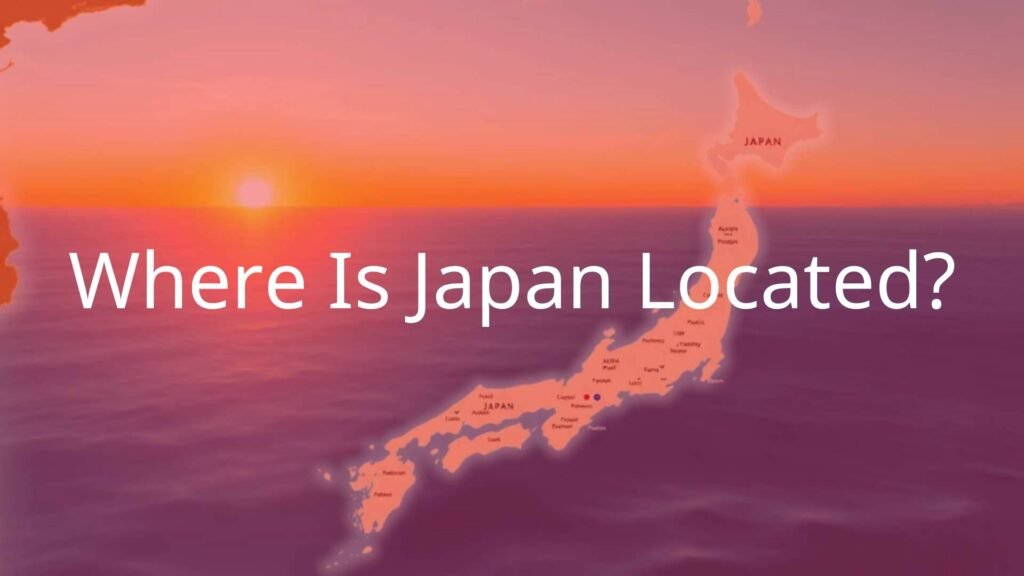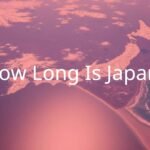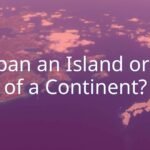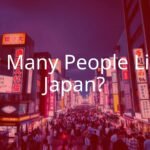Japan is a country made up of islands in East Asia. It sits in the Pacific Ocean, to the northeast of the main part of Asia. People often call Japan the “Land of the Rising Sun” because it is one of the first places in Asia to see the sunrise. Its location has played a big role in shaping Japan’s culture, history, and how it interacts with other countries.

Japan is made up of a long chain of islands that stretch from the northeast to the southwest. Because of this, Japan is mainly a country focused on the sea. Its islands reach from the chilly waters of the Sea of Okhotsk in the north to the warmer East China Sea in the south. Even though Japan is not a large country by land area, it is important around the world and has always depended on its nearby seas and neighbors.
Where Is Japan on the World Map?
Looking at a world map, you can find Japan as a group of islands that curve along the eastern edge of Asia. Its position is important because it sits between the Asian continent and the Pacific Ocean. This spot has meant Japan sometimes interacts a lot with other places but has also spent times cut off from the world, often because of its geography.
Japan covers about 377,975 square kilometers (145,937 square miles). This means it is bigger than the United Kingdom and Italy, even if it doesn’t always seem so. Most people in Japan live in the flat, eastern parts, since most of Japan is covered by mountains. The closeness to the sea means no one in Japan lives more than 70 miles from the coast, making fishing and other sea-based jobs very important there.

Which Hemispheres Is Japan In?
Japan is located in the Northern Hemisphere and Eastern Hemisphere. Because it is north of the equator, Japan has four seasons: spring, summer, autumn, and winter. These seasons can feel very different in different parts of Japan, from cold in the north (Hokkaido) to warm and tropical in the south (Okinawa).
In the Eastern Hemisphere, Japan has the same time zone as other East Asian countries. This place makes Japan one of the first countries to start a new day, which is part of the reason for its nickname, the “Land of the Rising Sun.” Its location has helped Japan act as a bridge between countries in the East and in the West.
What Are Japan’s Coordinates?
Japan stretches across a wide range of latitude and longitude. Here are its main points:
- Northernmost point: Etorofu Island at 45°33’26” North
- Southernmost point: Oki-no-Tori Shima at 20°25’31” North
- Easternmost point: Minami-Tori Shima at 153°59’12” East
- Westernmost point: Yonagunijima Island at 122°55’57” East
Tokyo, the capital, is near the middle of the country’s main islands at about 35°41′ N and 139°45′ E, making it a central hub.

Japan and Its Nearby Countries
Japan’s closest neighbors are across the seas, as it is made up of islands. To the west across the Sea of Japan are South Korea and North Korea, and farther away, China. Over many years, Japan has shared culture, trade, and sometimes conflicts with these countries. For example, China and Korea have both influenced Japan’s language, religion, and arts.
To the north, the La Perouse Strait separates Japan from Russia’s Sakhalin Island. To the south, Japan is close to Taiwan and the Philippines. Because of its place, Japan often works with these countries, but sometimes has disagreements about the borders in the surrounding seas.
What Is Japan Like Geographically?
Japan’s land is mostly made up of mountains and surrounded by the sea. It is built by strong movements of Earth’s plates and sits on the Pacific Ring of Fire, where earthquakes and volcanoes are common. Mountains cover about 80% of the land, so most people live on small, flat areas.
The weather in Japan is different from the north to the south. Some parts are cold, while others are hot and humid. These differences mean Japan has many kinds of plants and animals. The mountains, rivers, and small areas for farming have all affected how people live and what kind of activities and culture have grown there. For example, Japanese gardens often copy natural landscapes.

Is Japan Made of Islands?
Yes, Japan is made up of islands-over 14,000 of them. This fact shapes daily life, defense, food, and more. Seafood is a big part of Japanese meals because the sea is always nearby. In fact, no matter where someone lives in Japan, they are never more than 70 miles from the coast.
Most people and cities are on the four largest islands, but the thousands of smaller islands give Japan a very long coastline, about 29,751 km (18,486 miles)-the sixth-longest in the world. Being separated by water helped protect Japan in the past and let unique customs and ways of life grow.
Main Islands of Japan
| Island | Description |
|---|---|
| Hokkaido | The northernmost island, known for cold weather and big forests. |
| Honshu | The largest and most populated island. Major cities like Tokyo and Osaka are here. |
| Shikoku | The smallest of the four big islands; known for mountains and an 88-temple pilgrimage. |
| Kyushu | The southernmost large island, famous for active volcanoes and hot springs. |
Other important island groups include the Ryukyu Islands (such as Okinawa) and the Nanpō Islands, which also extend Japan’s land further south and east.

Seas and Oceans Around Japan
- Sea of Japan: Lies to the west, between Japan and the Korean Peninsula and Russia. Important for fishing and ship travel; brings heavy snow to western Japan in winter.
- East China Sea: Southwest of Japan, connecting to China and Taiwan.
- Sea of Okhotsk: To the north, marking colder waters.
- Pacific Ocean: To the east and south of Japan, this ocean is key to the country’s weather and fishing. The Pacific also influences storms (like typhoons) and big waves (tsunamis).
Warm and cold ocean currents mix near Japan, making the seas great for fishing, which is important for Japan’s food and business.
What Countries and Regions Are Close to Japan?
Japan does not touch any country by land. But it shares sea borders, which means its neighbors are separated by water but still nearby. These nearby countries often work with Japan, but sometimes have disagreements about the sea areas, fishing, and natural resources.
Japan’s sea area, called its Exclusive Economic Zone (EEZ), covers about 4,470,000 square kilometers (1,730,000 square miles) and is one of the largest in the world. Japan’s many faraway islands help make its sea area even bigger. Even though Japan isn’t connected to other countries by land, the sea brings it close to them in many ways.
Japan’s Nearest Neighboring Countries
- South Korea and North Korea: Across the Sea of Japan, these countries are very close to Japan and have long histories of both working together and having disagreements.
- China: Across the East China Sea, China is both a big trading partner and sometimes a rival, especially over small islands.
- Taiwan: South of Japan, across the sea, Taiwan also has some disputes with Japan over islands and sea areas.
Japan’s Main Sea Borders and Economic Zones
The main seas that form Japan’s borders are the Sea of Japan, East China Sea, and the Pacific Ocean. These areas are important for fishing, shipping, and finding oil or gas. Sometimes Japan and its neighbors argue over who controls certain sea areas, especially when it comes to small islands. Here are some of the places where there are disputes:
- Russia: Over the Southern Kuril Islands
- South Korea: Over the Liancourt Rocks
- China and Taiwan: Over the Senkaku Islands
These disagreements show how important the sea is for Japan and its neighbors, both for business and for security.
- What Is a Maiko? - July 13, 2025
- What Does Domo Arigato Mean? - July 12, 2025
- What Does Naruto Mean? - July 12, 2025









